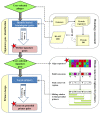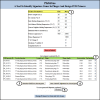PhiSiGns: an online tool to identify signature genes in phages and design PCR primers for examining phage diversity
- PMID: 22385976
- PMCID: PMC3314551
- DOI: 10.1186/1471-2105-13-37
PhiSiGns: an online tool to identify signature genes in phages and design PCR primers for examining phage diversity
Abstract
Background: Phages (viruses that infect bacteria) have gained significant attention because of their abundance, diversity and important ecological roles. However, the lack of a universal gene shared by all phages presents a challenge for phage identification and characterization, especially in environmental samples where it is difficult to culture phage-host systems. Homologous conserved genes (or "signature genes") present in groups of closely-related phages can be used to explore phage diversity and define evolutionary relationships amongst these phages. Bioinformatic approaches are needed to identify candidate signature genes and design PCR primers to amplify those genes from environmental samples; however, there is currently no existing computational tool that biologists can use for this purpose.
Results: Here we present PhiSiGns, a web-based and standalone application that performs a pairwise comparison of each gene present in user-selected phage genomes, identifies signature genes, generates alignments of these genes, and designs potential PCR primer pairs. PhiSiGns is available at (http://www.phantome.org/phisigns/; http://phisigns.sourceforge.net/) with a link to the source code. Here we describe the specifications of PhiSiGns and demonstrate its application with a case study.
Conclusions: PhiSiGns provides phage biologists with a user-friendly tool to identify signature genes and design PCR primers to amplify related genes from uncultured phages in environmental samples. This bioinformatics tool will facilitate the development of novel signature genes for use as molecular markers in studies of phage diversity, phylogeny, and evolution.
Figures




Similar articles
-
Development of phoH as a novel signature gene for assessing marine phage diversity.Appl Environ Microbiol. 2011 Nov;77(21):7730-9. doi: 10.1128/AEM.05531-11. Epub 2011 Sep 16. Appl Environ Microbiol. 2011. PMID: 21926220 Free PMC article.
-
A bioinformatic analysis of ribonucleotide reductase genes in phage genomes and metagenomes.BMC Evol Biol. 2013 Feb 7;13:33. doi: 10.1186/1471-2148-13-33. BMC Evol Biol. 2013. PMID: 23391036 Free PMC article.
-
Development and evaluation of taxon-specific primers for the selected Caudovirales taxa.Virus Res. 2019 Apr 2;263:184-188. doi: 10.1016/j.virusres.2019.02.005. Epub 2019 Feb 12. Virus Res. 2019. PMID: 30769122
-
Global overview and major challenges of host prediction methods for uncultivated phages.Curr Opin Virol. 2021 Aug;49:117-126. doi: 10.1016/j.coviro.2021.05.003. Epub 2021 Jun 12. Curr Opin Virol. 2021. PMID: 34126465 Review.
-
Origin, Evolution and Diversity of φ29-like Phages-Review and Bioinformatic Analysis.Int J Mol Sci. 2024 Oct 9;25(19):10838. doi: 10.3390/ijms251910838. Int J Mol Sci. 2024. PMID: 39409167 Free PMC article. Review.
Cited by
-
Phages from Ganges River curtail in vitro biofilms and planktonic growth of drug resistant Klebsiella pneumoniae in a zebrafish infection model.AMB Express. 2021 Feb 15;11(1):27. doi: 10.1186/s13568-021-01181-0. AMB Express. 2021. PMID: 33587215 Free PMC article.
-
De-MetaST-BLAST: a tool for the validation of degenerate primer sets and data mining of publicly available metagenomes.PLoS One. 2012;7(11):e50362. doi: 10.1371/journal.pone.0050362. Epub 2012 Nov 26. PLoS One. 2012. PMID: 23189198 Free PMC article.
-
Diversity of environmental single-stranded DNA phages revealed by PCR amplification of the partial major capsid protein.ISME J. 2014 Oct;8(10):2093-103. doi: 10.1038/ismej.2014.43. Epub 2014 Apr 3. ISME J. 2014. PMID: 24694711 Free PMC article.
-
Bioinformatic Tools and Guidelines for the Design of Fluorescence In Situ Hybridization Probes.Methods Mol Biol. 2021;2246:35-50. doi: 10.1007/978-1-0716-1115-9_3. Methods Mol Biol. 2021. PMID: 33576981
-
MRPrimerW: a tool for rapid design of valid high-quality primers for multiple target qPCR experiments.Nucleic Acids Res. 2016 Jul 8;44(W1):W259-66. doi: 10.1093/nar/gkw380. Epub 2016 May 6. Nucleic Acids Res. 2016. PMID: 27154272 Free PMC article.
References
-
- Breitbart M, Thompson L, Suttle C, Sullivan M. Exploring the vast diversity of marine viruses. Oceanography. 2007;20:135–139.
-
- Weinbauer MG, Rassoulzadegan F. Are viruses driving microbial diversification and diversity? Environ Microbiol. 2004;6:1–11. - PubMed
Publication types
MeSH terms
Substances
LinkOut - more resources
Full Text Sources

